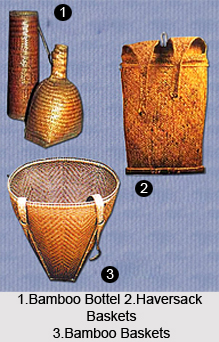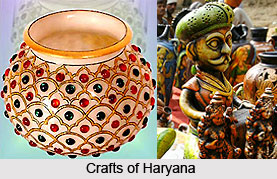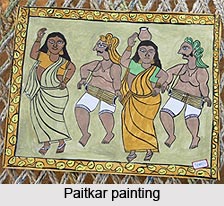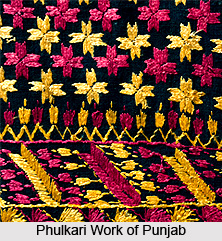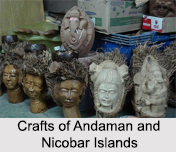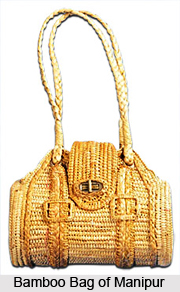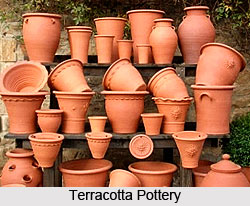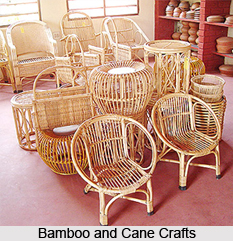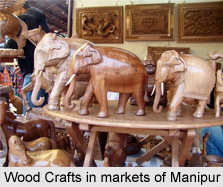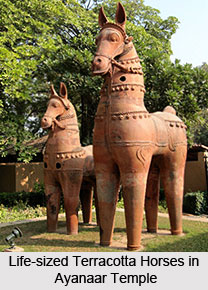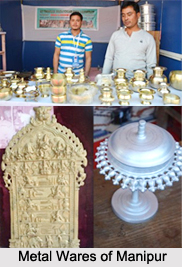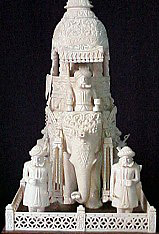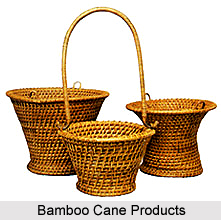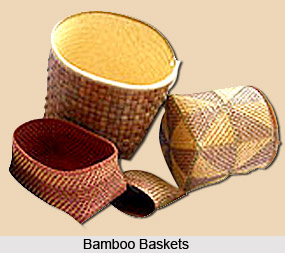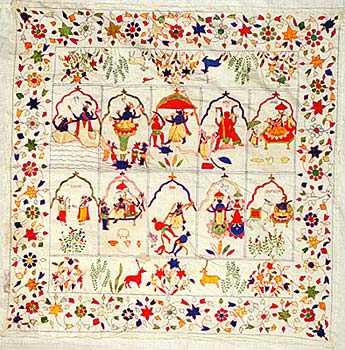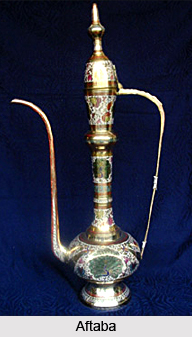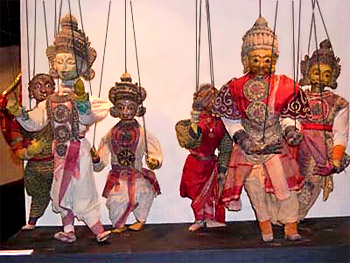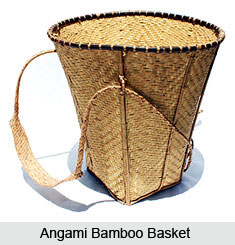 Bamboo and cane crafts of Nagaland have retained their popularity and utility even today, despite being an ancient traditional art. Residents of Nagaland utilize bamboo and cane for a variety of purposes which include household items for daily use, construction and multiple other products. There are no professional bamboo or cane weavers in Nagaland as every common man is capable of creating his own bamboo merchandise.
Bamboo and cane crafts of Nagaland have retained their popularity and utility even today, despite being an ancient traditional art. Residents of Nagaland utilize bamboo and cane for a variety of purposes which include household items for daily use, construction and multiple other products. There are no professional bamboo or cane weavers in Nagaland as every common man is capable of creating his own bamboo merchandise.
Bamboo products are so intrinsically attached to the lives of Naga tribes that is stated that they start their lives `in a cradle of bamboo and end their lives in a coffin of bamboo`. Bamboo and cane crafts of Nagaland is restricted to men. Naga women who carry beautifully woven bamboo baskets are held in high esteem in Nagaland. These handicrafts are not only renowned in India, but have also won international admiration. The Khonoma village in Nagaland is particularly well known for their intricate weaves and designs that carry the tradition of bamboo and cane crafts of Nagaland. The baskets of Khiamngan weavers in the Tuensang district are also known for their finesse and delicacy of work that gives it a lace-like appearance in creating cane baskets and containers.
Folklore of Bamboo and Cane Crafts of Nagaland
There exists an ancient story which connects the age-old tradition of basketry in Nagaland to the remote past. This account is based on an `Ao` folk tribe tale. According to Ao tribes there was once a magician named Changkichanglangba. During his lifetime he used to entertain people through his different magical tricks and miracles. Prior to his death, he had instructed his people to open his grave on the sixth day after his burial. He had added that if they did as directed, they would discover some brand new objects. When the magician died and everyone opened his grave, they obtained various kinds of designs and motifs related to the art of basketry. Impressed by the new patterns of the basketry work, the people started imitating those styles and introduced those very techniques while making their baskets. This craft was widely practised and passed onto future generations of the Nagas.
Cane Crafts of Nagaland
Cane Craft is used extensively by the Nagas to make coarse baskets, furniture, utensils and dress materials. They are expert craftsmen when it comes to making mugs, bowls, containers, haversacks, and mats, with colourful inscriptions upon them. The haversacks are made of thick clothes, which are sewn by cane frames and embellished with shells and beads. Naga artisans also employ cane to make jewelleries like necklace, armlets, bangles, leg-guards and head bangles. Cane neckbands and leggings (known as `phipha` and worn by Ao and Angami Naga men) are dyed red and worn by Naga tribals, in combination with orchid stems and cowrie shells. Konyak tribal men wear cane belts around their waists in about eight loops, throughout their lives. They absorb the body oils and consequently transform into golden yellow coloured accessories. Cane chairs, tables and sofas are the other products quite popular among the natives. Other variations are cane helmets, hat frames, cane-rain proof hats etc. Mats woven of cane strings with fine texture have decorative value in the recent market.
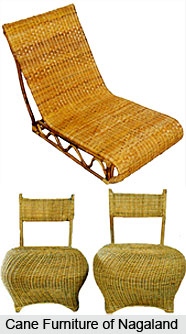 Bamboo Craft products of Nagaland
Bamboo Craft products of Nagaland
Nagas utilize bamboo for manufacturing various types of products like baskets, mats, furniture, musical instruments, weapons, costumes and utensils.
Bamboo Baskets of Nagaland
Baskets are the most common products composed of bamboo. The `Angami` tribe of the Nagas is proficient in the craft of basket weaving. Baskets used by Nagas are available in different designs, shapes and sizes, depending on the kind of purpose they serve. All the Naga womenfolk carry a `khopi` basket, irrespective of their ages. Khopi baskets consist of a footstool, with a jute belt and a leather strap for attaching it to their foreheads. Some baskets are devoid of the footrest and are called `koshi`.
Generally, baskets of Nagaland fall into two distinct categories, the ones used for storage purposes in households and the others which are exclusively used for regular daily activities like carrying goods from one place to another, on the shoulders. The residents of Nagaland use many kinds of baskets, each built uniquely and bearing a symbolic meaning. The type of basket also varies from tribe to tribe in this state. For instance, the baskets carried by Ao tribals are conical in shape, while those transported by Angami tribals are cylindrically shaped with its mouth comparatively wider than its base. Conical baskets are termed as `akhi` and `akha`, and are made from split of bamboo. They are interconnected in a technique similar to threads which are interwoven during weaving.
Cylindrical baskets are usually flat-bottomed, twill-patterned and very water-tight as they are woven quite tightly. Nagas use these products to strain the rice beer. `Chang` women often use decorative baskets for carrying their thread while they knit. `Konyak` baskets are ornamental baskets, with figures and hairs are also carried by Naga women. The Nagas use little repositories which are used for purposes like stashing an alive chicken into them for journeys, or carrying loads of rice grains or other crops from the fields. Hexagonal baskets, with lids on top are known as `japas` in the native tongue of the Nagas. There are certain types of baskets, woven in complicated designs, used as wine bottles. `Mpua` is a kind of basket used by `Zeme` Nagas for carrying paddy.
Domestic Bamboo Crafts of Nagaland
Splits of bamboo are developed into several forms of utensils like dishes, saucers, Angami Naga bamboo spoons, Chang bamboo mugs and hayforks termed as `kedzu`. These are very advanced form of crafts, made by skilled artisans of Nagaland. Each domestic item is created by cutting and processing bamboos in various manners. The Changs make attractive `chungas` or drinking cups. These cups are sometimes designed with painted stylized floral patterns or with human figures done in relief, greatly enhancing the shape and the texture of the items. `Lithuo` is a fishing tray made of bamboo that is used by the tribal people in Nagaland. Nagas prepare twilled bamboo mats out of finely split bamboo. Bamboo cradles, tables, chairs and sofas are utilized extensively in Nagaland.
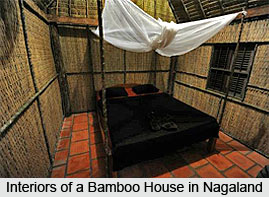 Bamboo Weapons of Nagaland
Bamboo Weapons of Nagaland
Chang Naga cross-bow is made from a combination of bamboo, wood fibre and bone. This weapon can be called a replica of the ordinary bow and arrow, though shooting a bamboo cross bow is tougher as compared to the former mainly due to the thickness of the bamboo bow. Bamboo shields are frequently used by the tribal as effective weapons and as protection from enemy attacks.
Bamboo Headgears of Nagaland
Ao tribesmen wear elaborately decorated ceremonial headgears which are conical. Some of the natives also prefer wearing hats made of cane strips. These hats are of two layers. The inner layer defines its structure and the external layer flaunts the adornments like yellow or black strips, boar tusks or hornbill feathers.
Bamboo Musical Instruments of Nagaland
Nagas are passionate about music and produce all kinds of music with the aide of many instruments, which are pleasant to the ears. Flutes, trumpets, mouth organs and the cup violin are the multiple musical equipments manufactured by the Nagas. The natives of Nagaland also make harps.
Bamboo Costume Accessories of Nagaland
Beautiful, little combs are manufactured by Naga men. They are meant to be presented as gifts to the Naga girls.
Bamboo for Construction Purposes in Nagaland
Naga men use bamboo for constructing houses and also the floors of houses. The bamboo and cane crafts of Nagaland are an inseparable part of the tradition and culture of the region. As the bamboo and cane crafts have absorbed a major part of the tradition and established the craft as a hallmark of the consummate skill, expertise, talent and creativity of the tribal craftsmen.
